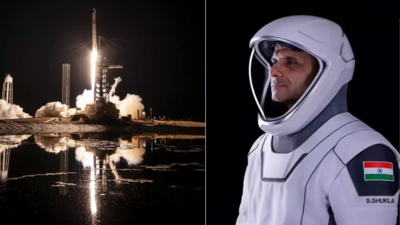India Celebrates as Shukla Reaches ISS, Pioneering New Frontiers in Space Exploration

Shubhanshu Shukla has made history as the first Indian to board the International Space Station (ISS), marking a significant milestone for India's space program. Shukla's arrival was met with enthusiastic greetings as he floated onto the ISS amidst cheers.
The spacecraft "Grace," the fifth in the Dragon series, executed a flawless docking with the ISS at 16:01 IST over the North Atlantic Ocean on Thursday.
Shukla is only the second Indian to venture into space, following Rakesh Sharma's groundbreaking mission in 1984. Accompanying Shukla on the Axiom-4 mission are Slawosz Uznanski-Wisniewski, representing Poland's return to space since 1978, and Tibor Kapu, Hungary's first astronaut in 45 years. The crew's journey began on Wednesday with a launch from NASA's Kennedy Space Center.
What's Next for India's Space Ambitions?
India has already demonstrated its capabilities in space with successful missions such as placing an orbiter around Mars and achieving a soft landing of a robotic spacecraft near the Moon's south pole.
Shukla's current experiments aboard the Axiom-4 mission are specifically designed to bolster the Gaganyaan program. His research is concentrated on the effects of microgravity on plant growth, muscle loss, mental health, and microbial behavior. These are crucial areas for ensuring the success of long-term human spaceflight. He is also studying tardigrades to gain insights into survival mechanisms under extreme conditions. The goals of these experiments are to develop sustainable space food systems, safeguard astronaut well-being, and refine life support strategies for future Indian space missions.
The NISAR mission overcomes the limitations of traditional Earth-observing satellites, which are often restricted by daylight and weather conditions. By utilizing advanced radar technology, NISAR can provide 24/7, all-weather imaging capabilities. This will result in more accurate and consistent monitoring of natural disasters, environmental changes, and agricultural trends.
NISAR is poised to revolutionize the fields of science, agriculture, and disaster response on a global scale.
Newer articles
Older articles
 Chess Star Praggnanandhaa Weighs In on Carlsen's Frustration After Loss to Gukesh
Chess Star Praggnanandhaa Weighs In on Carlsen's Frustration After Loss to Gukesh
 Samsung Galaxy A35 5G and A55 5G: Official Pricing and Availability Announced
Samsung Galaxy A35 5G and A55 5G: Official Pricing and Availability Announced
 India's Fielding Woes Blamed for First Test Defeat Against England: Former Selector Voices Concerns
India's Fielding Woes Blamed for First Test Defeat Against England: Former Selector Voices Concerns
 Headline: Viral Optical Illusion: Can You Find All the Hidden Animals? Only 1% Succeed
Headline: Viral Optical Illusion: Can You Find All the Hidden Animals? Only 1% Succeed
 Shadman Stands By Bangladesh Batters After Day 1 Struggles Against Sri Lanka
Shadman Stands By Bangladesh Batters After Day 1 Struggles Against Sri Lanka
 Norris Claims Thrilling Austrian GP Victory After Intense Duel with McLaren Teammate Piastri
Norris Claims Thrilling Austrian GP Victory After Intense Duel with McLaren Teammate Piastri
 Jake Paul's Title Dreams: Analyzing Championship Prospects and Potential Opponents
Jake Paul's Title Dreams: Analyzing Championship Prospects and Potential Opponents
 Gavaskar Urges India to Unleash Kuldeep Yadav in Second Test Amid Bumrah Fitness Concerns
Gavaskar Urges India to Unleash Kuldeep Yadav in Second Test Amid Bumrah Fitness Concerns
 iQoo Z9 Turbo Leaks: Snapdragon 8s Gen 3, 1.5K Display, and Massive Battery Detailed
iQoo Z9 Turbo Leaks: Snapdragon 8s Gen 3, 1.5K Display, and Massive Battery Detailed
 Mirabai Chanu Reveals Relentless Dedication: Training and Weight Always Top of Mind, Even During Family Time
Mirabai Chanu Reveals Relentless Dedication: Training and Weight Always Top of Mind, Even During Family Time